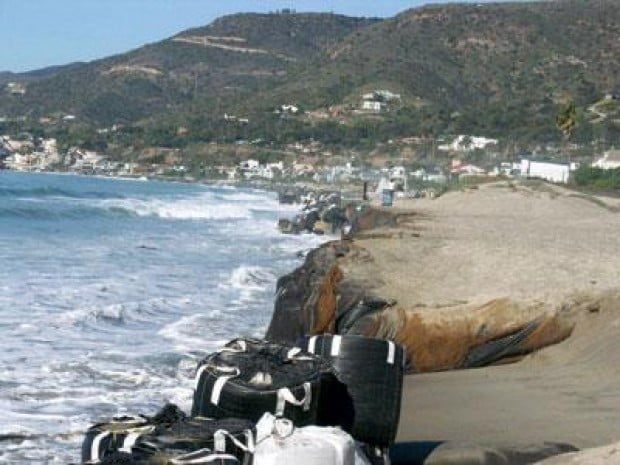
The privately funded, $20 million project would widen the heavily eroded beach by 100 feet. But opposition from a beauty product magnate has been increasing as a March 11 vote among property owners nears.
By Jimy Tallal / Special to The Malibu Times
As a key vote approaches March 11 among Broad Beach property owners on the plan to widen the heavily eroded beach, at least one property owner has ramped up efforts to stop the project.
Citing negative environmental side effects and loss of privacy to beach residents, a website called “Friends of Broad Beach” (FBB) started by property owner Paula Kent Meehan seeks to persuade her fellow property owners to vote “no” on beach nourishment. Meehan is the founder of Redken, a hair and skin product manufacturer.
The project would widen the beach 100 feet, restoring it to where it was before natural and man-made forces began eroding it away in the 1970s. It would also raise the dunes using sand dredged from offshore and onshore sources, as well as bury an existing wall of rock boulders, called a rock revetment. It is expected to cost approximately $20 million and will be privately funded by Broad Beach property owners.
The property owners in 2011 banded together to form a Geologic Hazard Abatement District (GHAD), which in this case is similar to an assessment district, to divvy up costs among property owners. The GHAD contains 121 parcels and 114 separate property owners, of which Meehan is one, and includes all of the property from Trancas Creek to Lechuza Point.
Property owners have until March 11 to submit a ballot either for or against placing an assessment cap of $400 per linear foot of beachfront. If enough people vote “no” there will not be any money to pay for it, which is apparently what FBB is aiming for. It is unclear what recourse the GHAD has if the vote fails.
The website, which launched in January, explains how to legally withdraw a “yes” vote and change it to a “no” vote, and makes a number of claims challenging the facts put forward by the GHAD Board of Directors.
Kenneth A. Ehrlich, attorney for the Broad Beach GHAD, believes that FBB is just Meehan herself. Meehan’s attorney Allan Abshez said that was untrue, but said they were afraid to speak.
“There’s a group of about a dozen people concerned or opposed to the assessment,” Abshez said, but “there’s a climate of intimidation out there for opposing the project, and people have said they’re afraid of being publicly identified.”
Abshez said that some homes, including Meehan’s, are up on rocky cliffs not affected by wave action or beach erosion. Because of that, Abshez said these homes wouldn’t get any direct benefit from widening the beach and shouldn’t have to pay for it. In addition, since the state would benefit from beach restoration below the high tide line, Abshez contends that “The GHAD should not pay to improve state property,” Abshez said.
But aside from the funding squabbles, the website takes aim at the project in general.
For starters, the website declares that the environmental side effects of adding large amounts of sand to Broad Beach are unclear and have not been studied.
Ehrlich countered that analysis of the project has been ongoing by the California State Lands Commission since last summer. He said the Coastal Commission and seven or eight other agencies would also be providing “significant and substantial [environmental] review.”
Stephanie Danner, senior planner for the City of Malibu, told The Malibu Times the review process by the State Lands Commission has not been completed, and it may be June before Broad Beach can apply for its coastal development permit on the project.
The website also argues that Broad Beach property owners will be paying to develop a major public beach and would be required by the Coastal Commission to remove their septic systems and donate trail easements across their properties, all with no guarantee that the beach nourishment would succeed.
Ehrlich said the charge that property owners would have to remove their septic systems was “not true,” an opinion he based on what he said were at least seven meetings with Coastal Commission staff. He also disagreed about the trail easements, stating that the expanded sand dunes are an environmentally sensitive habitat area (ESHA), and could not have trails on them.
Regarding the ultimate success of the project, Ehrlich acknowledged that it was not a permanent solution, but said a respected engineering firm retained by the GHAD had said it would last for 10 years.
As an alternative to beach nourishment, the website suggests pursuing a permit from the California Coastal Commission to make the rock revetment permanent instead. The revetment was installed in 2010 as an emergency measure to stop flooding the yards of the homes on the severely eroded beach. It cost an estimated $3 million to property owners, according to Ehrlich.
But Ehrlich said leaving the revetment without doing beach nourishment is not an option, because it is explicitly stated in the state permit that the GHAD will have to pay to remove the existing rock wall if the rest of the beach expansion project isn’t completed.

